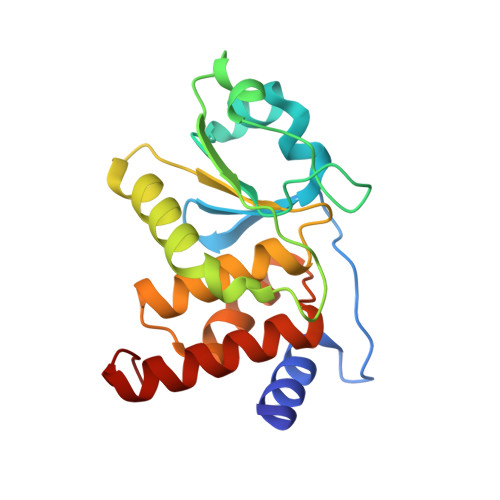Fragment Screening Identifies Novel Allosteric Binders and Binding Sites in the VHR ( DUSP3 ) Phosphatase.
Wu, J., Baranowski, M.R., Aleshin, A.E., Isiorho, E.A., Lambert, L.J., De Backer, L.J.S., Han, Y.N., Das, R., Sheffler, D.J., Bobkov, A.A., Lemberikman, A.M., Keedy, D.A., Cosford, N.D.P., Tautz, L.(2025) ACS Omega 10: 4912-4926
- PubMed: 39959108
- DOI: https://doi.org/10.1021/acsomega.4c10321
- Primary Citation of Related Structures:
8TK2, 8TK3, 8TK4, 8TK5, 8TK6, 9DJ9 - PubMed Abstract:
The human Vaccinia H1-related phosphatase (VHR; DUSP3 ) is a critical positive regulator of the innate immune response. Recent studies suggest that inhibiting VHR could be beneficial in treating sepsis and septic shock. VHR belongs to the superfamily of protein tyrosine phosphatases (PTPs), a large class of enzymes that are notoriously difficult to target with small molecules. Fragment-based drug discovery (FBDD) has emerged as an effective strategy for generating potent ligands, even for challenging drug targets. Here, we present a fluorine NMR-based discovery platform for identifying fragments that bind to VHR. This platform encompasses automated library assembly, mixture formation, quantitative material transfer, fluorine NMR screening, and biophysical hit confirmation. We demonstrate that this streamlined, integrated screening workflow produces validated hits with diverse chemical matter and tangible structure-activity relationships (SAR). Crystal structures yielded detailed information on the fragment-protein interactions and provide a basis for future structurally enabled ligand optimization. Notably, we discovered novel ligand binding sites on VHR, distant from the conserved active site, facilitating the generation of selective VHR modulators. This fragment discovery platform can be applied to other PTPs and holds significant potential for identifying potent and selective ligands.
- Cancer Molecular Therapeutics Program, NCI-Designated Cancer Center, Sanford Burnham Prebys Medical Discovery Institute, 10901 N Torrey Pines Rd, La Jolla, California 92037, United States.
Organizational Affiliation:



















